
Dry skin on a child’s legs is a common problem caused by both improper care of the baby and a number of diseases that require competent professional treatment. If a child’s skin is peeling and dry, the triggering factors should be identified and the necessary measures taken to solve this problem.
Causes of dry and rough skin
The skin of a baby is distinguished by tenderness, thinness and increased sensitivity. Pediatricians identify the following causes of skin problems in children under three years of age:
- Incorrect, unbalanced diet. A lack of vitamins and microelements in a child’s body affects the condition of his skin, making it pale, dry, rough and flaky.
- Violation of the drinking regime. If a baby drinks less than 1.5 liters of water during the day, this leads to dehydration and dry skin.
- Unsuitable cosmetics (baby cream, soap and other hygiene products). It is important to select high-quality cosmetics that include only natural ingredients and are appropriate for the child’s age.
- Allergic reactions.
- Hormonal disorders.
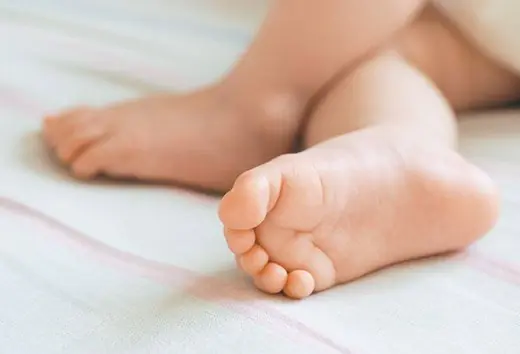
In some situations, dry skin becomes due to frequent bathing, dry indoor air and other external factors.
However, sometimes a similar phenomenon in children can act as one of the symptoms of diseases that require competent and timely treatment:
- Atopic dermatitis is a hereditary allergic disease. With this pathology, the child’s skin (not only on the legs, but also on the face and other parts of the body) becomes dense, rough, and covered with crusts.
- Eczema - accompanied by dryness, itching and burning sensation in the affected areas.
- Dermatitis - with this disease, individual dry spots appear on the child’s skin, having a predominantly round shape.
- Renal pathologies - manifested by disturbances in the process of urination, painful sensations localized in the lumbar region, permanent lack of appetite, and general weakness. The skin becomes not only dry, but also acquires a painful yellowish tint.
- Ichthyosis - with this disease, the skin becomes covered with blisters and specific scales.
- Hypothyroidism is a disease caused by disturbances in the functioning of the thyroid gland, accompanied by swelling, dry hair and skin, brittle nail plates, general weakness and increased fatigue.
If a child has such symptoms, especially if they persist for a long time, despite proper care for the baby, it is important to seek help from a doctor as soon as possible.
Dry skin in a newborn
The problem is often associated with the physiological characteristics of the structure of the outer covering of infants. The fact is that the baby has difficulties with heat transfer, which is associated with insufficient development of the sweat glands.
The epidermis of an infant contains an increased amount of lipids, which, on the one hand, protect his skin from external influences, but on the other, can lead to dryness and irritation.

The following factors can provoke the appearance of dry and rough skin in a newborn:
- general overheating of the body;
- prolonged exposure to the sun;
- the use of air conditioners and heaters that dry out the air in the room;
- violation of hygiene standards.
To avoid troubles such as dry skin, you need to properly care for your child and humidify the air during the heating season, using special devices for this purpose or placing containers of water around the apartment.
Why does an allergy affect the skin?
In most cases, a child’s rough skin, prone to dryness, is a sign of allergic manifestations. Why is this happening? The fact is that allergies, in essence, are the body’s defense against foreign proteins.
Specific allergen substances can also provoke its manifestation. In a small child, the immune and enzymatic systems are not yet sufficiently developed, so even many food products are perceived by the body as provoking allergens. Foreign substances are removed from the child’s body through the skin and urinary system, which is why they suffer the most.
Most often, children are susceptible to a disease such as atopic dermatitis. In newborn babies, with proper therapy, it is possible to quickly eliminate the symptoms of the pathology and stop the further development of the disease.
In children over the age of one year, the disease is severe, often accompanied by the appearance of ulcers and damage to the deep layers of the skin. Treatment is difficult, and often the disease becomes chronic. However, the lack of therapeutic measures is fraught with the development of dangerous consequences: rhinitis, bronchial asthma, eczema, etc.
Which doctor should I contact?
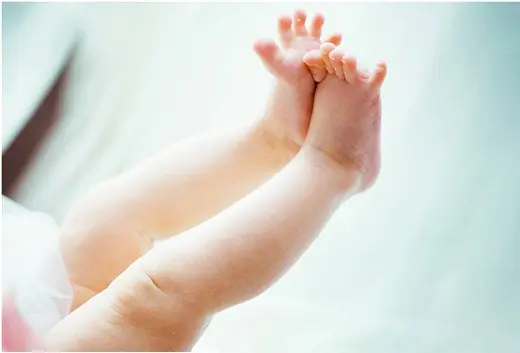
If your child has dry and rough skin on his legs, and even more so if there are other alarming symptoms, you should see a pediatrician.
The doctor will conduct an examination, study the clinical picture, analyze the collected medical history, and write out directions for tests. If necessary, the local pediatrician will refer you to such highly specialized specialists as a pediatric dermatologist, allergist, and endocrinologist.
Treatment
Therapy for dry skin of the feet in a child is prescribed individually, depending on the root causes that provoked this phenomenon and the age category of the little patient.
If dry skin is a symptom of a certain diagnosed pathology, then first of all it is necessary to treat the underlying disease. The course of health measures is developed by the doctor depending on the diagnosis, the age of the child, the stage and degree of the pathological process, and other features of a particular clinical case.
If the problem is caused by allergic reactions, poor nutrition or skin care for the baby, then it is enough to adjust your lifestyle to achieve positive results.
Medicines
Medications are prescribed for diseases such as dermatitis, diabetes mellitus, hypothyroidism, renal and endocrine pathologies. Systemic medications are selected by a doctor according to an individual scheme. If dry, rough spots appear on the baby’s skin, the use of external medications (Fenistil ointment, etc.) may be recommended.
In the case of atopic dermatitis or severe allergic manifestations, the child is prescribed ointments and creams that contain hormones - glucocorticosteroids. Such drugs provide a good therapeutic effect, but they should be used only as prescribed by a doctor, strictly observing the dosage.
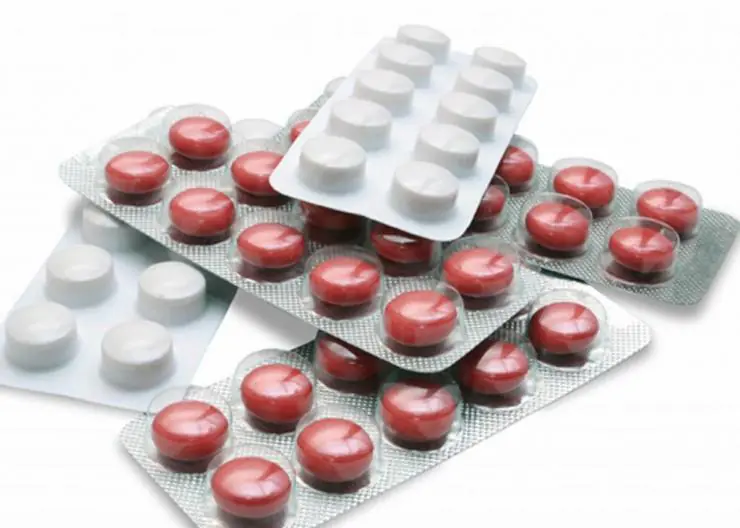
Hormonal drugs are discontinued gradually, reducing the amount of the drug over several days. In particularly complex, advanced cases, the use of antihistamines, calcium, and glucocorticosteroids may be recommended.
Diet
Diet therapy is the main method of treating and preventing dry skin in children. If the baby is breastfed, then the mother should exclude from the menu all foods that cause allergies.
If the problem arose after the introduction of complementary foods, it is recommended to restore the child’s usual diet for two weeks, and then reintroduce complementary foods.
Any product is included in the menu in a minimum quantity for three weeks. Such a scheme helps doctors identify the presence of a certain food allergen in a child that negatively affects the skin.
The basis of the baby’s diet should be the following foods:
- cucumbers, tomatoes;
- melon, pumpkin;
- spinach, carrots, cabbage;
- dairy and fermented milk products;
- eggs;
- porridge.
It is recommended to temporarily exclude sweets, fried foods, and citrus fruits from the menu of a small patient.
Folk remedies

Traditional medicine helps a child with dry skin. The simplest and most effective recipes are:
- Foot baths. Dissolve a tablespoon of vegetable oil in a bowl of warm water. The optimal duration of the procedure is about 10 minutes. Excellent results are obtained by foot baths with decoctions, infusions of rose petals, sage, and chamomile.
- Cucumber infusion – has moisturizing, regenerating, refreshing properties. To prepare the medicine, you need to finely chop several fresh cucumbers, immerse them in a liter jar and fill them with alcohol or vodka. Place to infuse in a dark, cool place for two weeks. After the specified period, cucumber tincture can be used to treat the baby’s feet 1-2 times a day.
- Lemon compress - softens the skin, gives it softness and elasticity. To make such a remedy, just apply a little lemon juice to a gauze cloth and apply it to the affected area of the child’s skin, securing it with a plaster or bandage. Recommended exposure time is 10 minutes.
In case of serious illnesses, folk recipes can only be used as an addition to the main treatment after consultation with a doctor, especially if we are talking about very young children.
Consequences
If timely measures are not taken, dry skin on a child’s feet can lead to the following complications:
- the appearance of painful cracks;
- ulcerative, erosive lesions of the skin;
- eczema;
- chronic form of atopic dermatitis.
If the cause of dry and rough skin lies in the last of the listed points, then the development of chronic allergic reactions, bronchial asthma, and neuropsychiatric disorders is possible.
Prevention

It is easier to prevent any problem than to treat it. To avoid dry and rough skin on a child’s feet, doctors advise parents to pay attention to the following preventive recommendations:
- Take care of the child’s proper, balanced nutrition, provide his body with the necessary amount of vitamins A, B and E.
- Give your child as much fluid as possible, especially during hot periods, giving preference to clean water, milk, natural juices, and fruit drinks.
- Use natural children's cosmetics and avoid regular soap.
- Choose high-quality shoes made of genuine leather for your child that match his size.
- Avoid using socks, tights, and rompers made from synthetic materials.
Dry skin on a child’s feet is not the most serious problem, but this symptom causes the baby some discomfort and may also indicate the development of serious allergic diseases. Therefore, you should not ignore such a manifestation. Provide your baby with proper care, and if this does not help, first consult a pediatrician.
It's hard not to be alarmed when baby's delicate skin suddenly becomes rough and rough. What happened, why did the skin become rough and is it dangerous? Should I go to the doctor or try to cope on my own?
In general, situations when you have to figure out why a child has rough skin can be divided into several fundamentally different groups:
When it's not a disease
Dry, rough skin in a child can appear either as a result of illness or simply under the influence of external factors: cold, wind, friction.
Friction
For example, the skin on a child's elbows may become rough, wrinkled and dark simply because they are often leaned on while lying down watching TV or playing with gadgets. The same rough brown or pinkish dry, rough patches may appear on the top of the foot if the child has a habit of sitting with one leg tucked under him, which constantly rubs against the upholstery of the chair.
Something similar can happen to the skin of the legs, or less often, it can appear on the hips if you wear woolen pants directly on the body. In this case, the rough red spots look like goose bumps. Actually, this is what it is, irritation appears due to the impact of coarse wool on children’s skin, which has become sensitive in the cold (however, similar problems also occur in adults).
Cold, wind
Children aged 7–10 years who begin to walk independently may develop pimples on their hands: the result of exposure to cold, moisture and wind (most often when walking in wet mittens or without mittens at all). Small rough bumps appear on the skin, it turns red and peels.
All these cases do not require medical intervention. It is enough to change the child’s habits so that the skin does not get injured again and again, and lubricate the areas of peeling with a rich, nourishing cream.
- This could be domestic hand cream with vitamin F, blue Nivea, Vaseline.
- One of the folk remedies is goose fat.
- It is not recommended to use oils in their pure form: any oil effectively moisturizes only after peeling, when keratinized particles of the epidermis have been removed. It is not worth scrubbing already irritated sensitive skin, so as not to further injure it.
In a newborn and a child up to one year old
In the first two weeks of life, dry, rough skin, fine peeling on the abdomen and sides of the child may be normal: this happens in about a third of babies. After removing the vernix, the skin becomes more sensitive to external influences and dry air in the room (especially in winter, when central heating is on) reduces the amount of moisture in the skin. No special measures are needed here: it is enough to bathe the baby regularly (provided that the umbilical wound has healed) and after bathing, lubricate the skin with baby oil or milk.
The skin of a healthy baby can dry out and peel if:
- too dry air in the house,
- excessive use of baby powder,
- bathing too often with soap or foam,
- adding string, chamomile, oak bark to the bath.
All this is quite easy to detect and eliminate.
Diaper dermatitis
Rough skin on the bottom of an infant can become a manifestation of diaper dermatitis, when the skin begins to swell due to excess moisture or is injured by the diaper. In this case, in addition to peeling on the skin, red swollen areas appear that appear denser and seem to rise above the surface. The redness does not have clear outlines, gradually fades away, and is often covered with small papules (tubercles), which can spread beyond the area of redness. When the process begins to fade, the redness disappears, but peeling and sometimes rough skin remains. Diaper dermatitis is always limited to the diaper area, the spots are uneven, and “drips” around the elastic bands are often visible.
This situation can hardly be called a variant of the norm, but there is no reason to panic. If you take measures in a timely manner, preventing infection from occurring, you can cope with the problem without a doctor. The diaper must be changed at least once every 2 hours. The baby's skin should be kept clean; when changing a diaper, any remaining urine should be removed with wet wipes. Areas of inflammation are treated with zinc powder or zinc ointment. If the problem is limited to mild redness and peeling, you can use creams with a healing effect (Bepanten).
If, with regular care and timely diaper changes, the situation does not change within 5 days, you need to consult a doctor.
When rough skin is a disease
- Hives
- Atopic dermatitis
- Eczema
- Psoriasis
Other diseases that can cause dry and flaky skin include: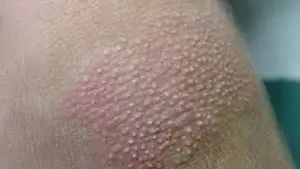
- follicular hyperkeratosis (goose bumps);
- congenital thyroid deficiency (hypothyroidism);
- congenital diabetes mellitus;
- a rare hereditary disease – ichthyosis;
And also some body conditions:
- lack of vitamins;
- helminthic infestation.
Allergic diseases
Allergy is one of the main problems of our time: according to WHO, a third of the population of developed countries already suffers from one or another of its manifestations, and in the future the number of such patients will increase. Proponents of the hygienic theory of allergies believe: the problem is that we live in a too clean, almost sterile world, and the immune system, due to the lack of real “enemies,” attacks the proteins of its own body.
Allergic reactions and diseases associated with excessive allergic readiness of the body often manifest themselves on the skin.
Hives
In appearance, this reaction is similar to traces of a nettle burn; the skin becomes rough, bumpy, swells, sometimes blisters appear (and sometimes the matter is limited to swelling). The rashes are itchy and may be painful to the touch. The skin and mucous membranes are affected, the rash can spread throughout the body, on the back and abdomen, or be located only in certain areas (for example, with increased sensitivity to ultraviolet radiation, solar urticaria appears only on open areas of the body).
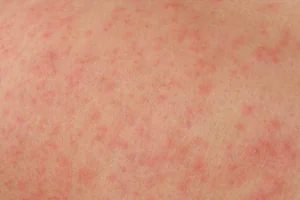
Hives can be triggered by food allergens (honey, citrus fruits), medications, insect bites, even cold and sun.
What distinguishes urticaria from skin diseases is the rapid appearance of many elements, while in skin diseases the rash begins with 1–2 elements and spreads over some time. Also, unlike skin diseases, rashes with hives last 1–2 hours, after which they disappear. The danger of this condition is that swelling of the mucous membrane can spread to the tissues of the larynx and impair breathing - this is called Quincke's edema. This condition requires immediate medical attention.
To treat urticaria, it is necessary to eliminate the allergen and take an antiallergic drug (loratadine, fexofenadine, cetrin). For food allergies, sorbents (Smecta, Polysorb, Enterosgel, Filtrum) are recommended; they will bind some of the allergens, preventing them from entering the blood. Fenistil can be used topically.
Atopic dermatitis
This is one of the most common causes of rough skin in a child. According to WHO, up to 15% of the world's population suffers from atopic dermatitis. Girls get sick more often than boys. The disease has a hereditary predisposition: if one of the parents has any allergies, the probability that the baby will develop atopic dermatitis is 20%; if both are allergic, the probability of the disease increases to 60%.
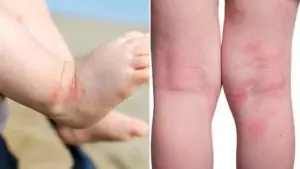
In essence, atopic dermatitis is an immune-dependent inflammation of the skin, during which the formation of the normal stratum corneum and lipid composition of the skin are disrupted. Speaking in Russian, due to inflammation caused by an allergic reaction, the skin produces too little fat and too many dead horn cells, which normally should protect it from external influences, but in atopic dermatitis, accumulating in excessive quantities, make the skin dry and rough.
Symptoms
The manifestations of atopic dermatitis depend on age. The disease usually appears at 1 year of age. In children (children aged 1–2 years), active inflammation predominates. Red, rough spots appear on the skin, covered with small nodules (papules) and small blisters that burst. forming weeping ulcers (erosions). Such rashes are located on the cheeks of a one-year-old child, less often on the forehead and chin, and on the hands.
As the child grows, the nature of the rashes and their prevalence change. Usually, after two years, the rough spots on a child’s skin become less bright, stop getting wet, and begin to peel off. And the skin itself becomes rough, its pattern intensifies and the lesions look wrinkled and may crack. The rash spreads to the neck and shoulders, elbow fossae, shins, popliteal fossae, gluteal folds, hands and feet. All these places are actively itchy, the child scratches them and can cause an infection. Then purulent crusts appear and the temperature rises.
Changes on the face are also possible: the eyelids darken, peel, and become wrinkled. Due to constant scratching, nails become smooth, shiny, and their edges wear down.
Usually the disease occurs as a series of exacerbations and remissions. Exacerbations occur more often in the cold season and are provoked not only by allergens, but also by stress and colds.
Treatment
Treatment of atopic dermatitis is complex and often unsuccessful. First of all, it is necessary minimize contact with allergens.
- A special diet is prescribed for this
Eggs, chocolate, citrus fruits, strawberries, factory juices, semi-finished products, and smoked meats are excluded from the diet. Sometimes this is not enough and you have to specifically identify foods that the child cannot tolerate, for example, cow's milk.
Let us dwell in more detail on nutrition for atopic dermatitis, because in children it is food allergens that most often provoke the disease. If the disease appeared before the introduction of complementary foods, the mother will have to take care of her diet, excluding the products mentioned above. An allergy can also occur to formula milk, then the problem should be discussed with a pediatrician who will help you choose a hypoallergenic product (alas, not a single hypoallergenic product actually guarantees the absence of a reaction.
If one or both parents are allergic, the baby is predisposed to atopic dermatitis. In this case, complementary foods should be introduced especially carefully: do not try to diversify tastes by adding one product once a week. Yes, the process will go slower, but it will be possible to track the baby’s reaction.
If the moment has already been missed, and at some stage of introducing complementary foods rashes appear, you will have to start all over again. For two weeks, the baby returns to exclusively breastfeeding. Then complementary feeding begins with minimal doses of one new product, gradually increasing the amount over two weeks. Only if it is well tolerated, the next one is added.
In older children, for whom mother's milk is no longer a necessity, but an addition to nutrition, it is necessary to use other schemes. First, almost everything is excluded from the diet. Only rice or buckwheat in water without oil or salt is allowed. Usually this stage is very difficult to survive: both the child and, especially, the grandmothers are indignant, trying to shove something “tasty” into their hands and accusing the young mother of abusing the child. Try to find an ally in the family who will take the fire.
After a week of such a strict diet, one new product is added. Further, new products are allowed every three days. Everything eaten and drunk during the day is carefully recorded in a food diary. Pay attention to hidden allergens: for example, eggs are often added to homemade cutlets.
- A change of scenery
If you have a baby at home with atopic dermatitis, you will have to change the environment. You need to remove carpets, drapes and other “dust containers” that harbor dust mites from your apartment. If there are feather pillows and duvets left in the house, you will have to remove them too. Check the bathroom for fungus: it often starts in hard-to-reach places, tile cracks. The fungus will also have to be removed regularly. Cleaning the house will have to be done every day: washing the floors can be replaced with a vacuum cleaner with a HEPA filter that does not allow small particles to pass through. A regular vacuum cleaner, on the contrary, only disperses allergens into the air. If finances allow, an air washer can be a good help, as it will maintain the desired level of humidity (which will have a beneficial effect on the skin of not only the baby, but also the mother), while simultaneously clearing the air of dust.
It is better to bathe your baby without soap and foam. You should not add potassium permanganate to the water - after the umbilical wound heals, the baby does not need sterility, and manganese dries out the skin. Herbs are also not useful - they themselves can become a powerful allergen. After bathing, you can lubricate your baby’s skin with special creams – emollients. Such creams are produced by many pharmaceutical cosmetics manufacturers. They can be used several times a day.
Drug therapy works in two main ways.
External therapy
Ointments with anti-inflammatory and antiallergic effects are used.
- Doctors often prescribe ointments with hormones (for example, methylprednisolone acetate) - there is no need to be afraid of them, these drugs are indicated in clinical recommendations as first-line therapy. Modern ointments with glucocorticoids are safe for a short course (no more than a month). But the dosage must be strictly observed. A strip of cream covering the end phalanx of the index finger is enough to spread over the area of two adult palms. If the area of the rash is smaller, accordingly, you need to take minimal amounts of the product. Do not mix hormonal ointments with petroleum jelly or baby cream - this will reduce the concentration of the active substance and the effectiveness of the drug.
- As an alternative to hormonal ointments, you can recommend the drugs pimecrolimus (Elidel), approved from the age of three months, or tacrolimus (Protopic), permitted from the age of two. For frequent exacerbations, pimecrolimus or tacrolimus can be used for prophylaxis, applied twice a week - according to this regimen, they are allowed to be used for a year or more.
- Lesions in the hair are treated with shampoos containing zinc pyrithione.
- Tar as a folk remedy for treating atopic dermatitis is effective, but has a carcinogenic effect.
General therapy or systemic antiallergic drugs
Loratadine (Claritin), ebastine (Kestin), cetirizine (Zyrtec). They reduce itching, especially at night, and swelling of the skin.
Children over three years old with extensive skin manifestations benefit from ultraviolet radiation: if it is not possible to sunbathe, you can use special devices in the physiotherapy rooms of clinics.
If atopic dermatitis appears at 1 year of life, there is a 60% chance that it will disappear over time. In general, the later the disease occurs, the more likely it is to last into adolescence and adulthood.
Eczema
Another hereditary disease caused by an inadequate immune response. Often combined with problems of the gastrointestinal tract and biliary tract.
The area of skin becomes red and swollen, and small blisters appear on it and burst. leaving behind pinpoint weeping ulcers (erosions), which doctors call eczematous wells. Then crusts appear on them. As it dissolves, new elements appear nearby, so you can simultaneously see different manifestations - redness, blisters, erosions, crusts, peeling. The boundaries of the lesions are unclear.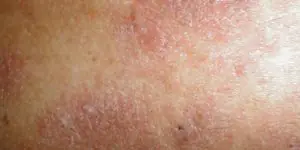
The rashes are symmetrical, the child has rough skin on the arms, legs, and face. Damaged areas alternate with clear skin, looking like an “archipelago of islands.” After the inflammation subsides, dense, darkened (or, conversely, pale) areas with rough, thick skin and an enhanced pattern remain, which gradually return to normal.
When the scalp is affected, seborrheic eczema occurs: yellowish or gray flaky and itchy crusts, yellowish-pink, swollen spots appear in the hair, behind the ears and on the neck, covered with greasy yellow flaky scales.
In children, the first signs of eczema usually appear between 3 and 6 months. Its manifestations are very similar to those of atopic dermatitis, the treatment is also similar: exclude all possible allergens, including food, ointments with glucocorticoids, oral antiallergic drugs, emollients several times a day to maintain the water-fat balance of the skin.
Psoriasis
Another disease in which skin changes are caused by an inadequate immune response. But unlike previous diseases, with psoriasis the trigger is infection: the disease often appears after chickenpox, tonsillitis, intestinal infections, or fungal infection. Most often this occurs between the ages of 4 and 8 years. The second peak incidence is adolescence.
If in adults psoriasis is rough, dry red scaly plaques, then in children it is most often red swollen spots, very reminiscent of diaper rash, but, unlike diaper rash, scaly. Such spots appear in the folds of the skin, on the genitals, face, and head. The plaques itch and flake off profusely. especially when combing, they often merge. About a third of children's nails change: indentations and transverse stripes appear in them. In adolescence, the elbows are often affected: groups of plaques with clearly defined boundaries gather around them, the skin is rough and red.
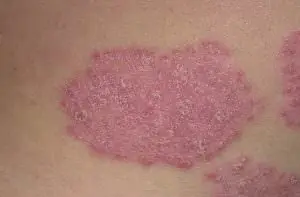
Just like atopic dermatitis or eczema, psoriasis gets worse. then goes into remission. The skin may clear completely, or a few “standby” plaques may remain. The duration of remission ranges from several weeks to tens of years.
Treatment of psoriasis begins with local therapy, the purpose of which is to remove peeling. To do this, use ointments based on salicylic acid, which soften the horny scales. The ointment is applied at night, washed off in the morning and the plaques are lubricated with ointments containing corticosteroids.
In severe cases, retinoids are prescribed orally - drugs based on active forms of vitamin A. But this is really a therapy for extreme conditions, which requires mandatory medical supervision.
Ultraviolet radiation helps well: it is useful for such children to sunbathe, and in winter to use artificial sources of ultraviolet radiation.
In the same way as with atopic dermatitis, a hypoallergenic diet is prescribed.
The manifestations of many skin diseases are very similar; it is difficult for a non-specialist to distinguish different types of rash from the descriptions. There is no need to try to diagnose and prescribe treatment on your own - there are dermatologists for that.
What happens is that inexperienced parents realize too late that their child has too rough skin on his body, which brings him a lot of inconvenience and discomfort. By the way, such a phenomenon can be a sign of quite serious diseases, and it is important to undergo a comprehensive examination in a timely manner in a children's clinic.
Why does the children's epidermis peel?
Rough skin in a child can be caused by a list of the following reasons:
- Acne caused by hormonal changes in the body of a newborn;
- Dry air in the baby’s place of residence;
- Lack of fluid, that is, dehydration;
- Deficiency of vitamins, minerals and nutrients in general;
- Using low-quality water for bathing or drying decoctions based on string, chamomile or oak bark;
- The influence of adverse weather conditions;
- Frequent use of industrial hygiene products: shampoos, foams and lotions for newborns;
- Abuse of baby powders;
- Dry skin can be the result of a latent form of diabetes. It can be noticed by a constantly increased appetite, the need to drink plenty of fluids and high glucose levels;
- Congenital hypothyroidism, in which the knees and elbows and legs and arms, respectively, are covered with dry patches of skin. Its top layer does not have time to renew itself due to too slow metabolism;
- Heredity;
- Ichthyosis, in which the skin over time becomes covered with whitish and grayish scales, peeling off as the dermis is renewed;
- Hyperkeratosis, as a result of which the skin on the body thickens its stratum corneum. The hips, feet, head and knees are most affected, and the disease itself can be either hereditary or caused by a lack of vitamins. Hyperkeratosis also occurs after prolonged use of hormonal medications, constant stress, gastrointestinal diseases, and even after using powders that are not suitable for the child;
- Worm infestation;
- Atopic dermatitis. In fact, this is a full-fledged allergic reaction, as a result of which at first one rough spot appears on the skin of a small child, but due to the presence of an allergen in food or the room, the defects spread throughout the entire dermis.
Atopic dermatitis
This allergic reaction in babies is encountered by mothers who smoke during breastfeeding, take antibiotics or hormonal medications, do not follow a diet and do not adhere to the rules of personal and child hygiene.
Irritating factors that can cause rough skin on a child’s body, legs and arms are:
- pet hair;
- tobacco smoke;
- household cleaners and detergents;
- food, unsuitable infant formula, and even mother's milk, which contains substances that are not perceived by the child's body.
In any situation, dryness is local in nature and does not spread throughout the entire skin. If a parallel infection with streptococcus occurs, weeping and foul-smelling crusts will begin to form on the child’s body.
If you contact a specialist at the initial stage of the disease, it can be treated quickly and easily. Advanced forms are accompanied by constant itching, the appearance of ulcers and bursting blisters, eczema, allergic rhinitis and even bronchial asthma.
Treatment for dry skin
The choice of therapy depends entirely on why the child has rough skin. For example, if the problem is caused by too dry air in the house, then frequent ventilation, installation of specific climate control equipment, daily wet cleaning, and removal of soft toys, heavy curtains and carpets are recommended.
If the first red, rough spot, and all subsequent areas of dryness on the child’s skin are the result of passive smoking, his parents will either have to completely get rid of their addiction to tobacco, or smoke outside their home.
One of the options for why babies' dermis peels may be the use of synthetic items in children's clothing and inappropriate care products. For example, you should wash your child’s clothes with special hypoallergenic and phosphate-free powders, rinse them three times, and wash your child’s dishes with soda or just hot water.
Bathing is organized using filtered water, adding decoctions of burdock, wren or yarrow to the bath. It is permissible to use soap and shampoos only a couple of times a week, and after water procedures, rub the child’s body with milk or lotion with a moisturizing effect.
Treatment of rough skin with dermatitis
Rough skin on a child’s body and legs becomes a good reason to visit a pediatrician. If a diagnosis of “dermatitis” is made, the specialist will suggest adjusting the diet of the mother and her child. At the same time, he will conduct a survey to identify a possible allergen. A nursing woman's stool frequency is monitored to rule out blood and milk intoxication.
In the case when the baby is bottle-fed, he is transferred to soy or lactose-free formulas. Often redness, dryness and peeling of the skin can be caused by the introduction of complementary foods. In this situation, it is recommended to return to your usual food and start complementary feeding a little later.
Exotic fruits and sweets, foods with preservatives and dyes, honey and other allergens are completely removed from the diet of a child with dermatitis. He is provided with the correct drinking regime, prescribed a specific diet and ensures regular bowel movements.
Drug therapy for rough areas of the dermis is reduced to the use of sorbents, glucocorticosteroid ointments, calcium supplements, antihistamines and sedatives. The latter are necessary to normalize the daytime and nighttime sleep of babies.
Monitor the condition of your child's skin and contact a specialist if these symptoms appear. We wish you and your baby good health!



